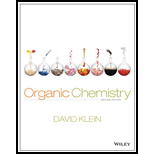
(a)
Interpretation:
Products should be drawn for the given reactions based on their reagents.
Concept introduction:
- Syn-dihydroxylation: syn- dihydroxylation is a process of adding two –OH groups from the same plane to the
alkene . - Trans-dihydroxylation: trans- dihydroxylation is a process of adding two –OH groups from different planes to the alkene
To find: the products during the syn-dihydroxylation of the trans-2-butene.
(b)
Interpretation:
Products should be drawn for the given reactions based on their reagents.
Concept introduction:
- Syn-dihydroxylation: syn- dihydroxylation is a process of adding two –OH groups from the same plane to the alkene.
- Trans-dihydroxylation: trans- dihydroxylation is a process of adding two –OH groups from different planes to the alkene
To find: the products during the anti-hydroxylation of the cis-2-butene.
(c)
Interpretation:
Products should be drawn for the given reactions based on their reagents.
Concept introduction:
- Syn-dihydroxylation: syn- dihydroxylation is a process of adding two –OH groups from the same plane to the alkene.
- Trans-dihydroxylation: trans- dihydroxylation is a process of adding two –OH groups from different planes to the alkene
(d)
Interpretation:
Products should be drawn for the given reactions based on their reagents.
Concept introduction:
- Syn-dihydroxylation: syn- dihydroxylation is a process of adding two –OH groups from the same plane to the alkene.
- Trans-dihydroxylation: trans- dihydroxylation is a process of adding two –OH groups from different planes to the alkene
To find: the products during the anti-hydroxylation of the cis-2-butene.
(e)
Interpretation:
Products should be drawn for the given reactions based on their reagents.
Concept introduction:
- Syn-dihydroxylation: syn- dihydroxylation is a process of adding two –OH groups from the same plane to the alkene.
- Trans-dihydroxylation: trans- dihydroxylation is a process of adding two –OH groups from different planes to the alkene
To find: the products during the syn-dihydroxylation of the trans-2-butene.
(f)
Interpretation:
Products should be drawn for the given reactions based on their reagents.
Concept introduction:
- Syn-dihydroxylation: syn- dihydroxylation is a process of adding two –OH groups from the same plane to the alkene.
- Trans-dihydroxylation: trans- dihydroxylation is a process of adding two –OH groups from different planes to the alkene
To find: the products during the anti-hydroxylation of the cis-2-butene.
Want to see the full answer?
Check out a sample textbook solution
Chapter 9 Solutions
Organic Chemistry
- a. H3C CH3 H, 1.0 equiv. Br2arrow_forwardH3C. H3C CH 3 CH 3 CH3 1. LDA 2. PhSeCl 3. H2O2arrow_forwardPlease predict the products for each of the following reactions: 1.03 2. H₂O NaNH, 1. n-BuLi 2. Mel A H₂ 10 9 0 H2SO4, H₂O HgSO4 Pd or Pt (catalyst) B 9 2 n-BuLi ♡ D2 (deuterium) Lindlar's Catalyst 1. NaNH2 2. EtBr Na, ND3 (deuterium) 2. H₂O2, NaOH 1. (Sia)2BH с Darrow_forward
- in the scope of ontario SCH4U grade 12 course, please show ALL workarrow_forwardIs the chemical reaction CuCl42-(green) + 4H2O <==> Cu(H2O)42+(blue) + 4Cl- exothermic or endothermic?arrow_forwardIf we react tetraethoxypropane with hydrazine, what is the product obtained (explain its formula). State the reason why the corresponding dialdehyde is not used.arrow_forward
- drawing, no aiarrow_forwardIf CH3COCH2CH(OCH3)2 (4,4-dimethoxy-2-butanone) and hydrazine react, two isomeric products are formed. State their structure and which will be the majority.arrow_forward+ Reset Provide the correct IUPAC name for the compound shown here. 4-methylhept-2-ene (Z)- (E)- 1-6-5-2-3-4- cyclo iso tert- sec- di tri hept hex oct meth eth pent ane yne ene ylarrow_forward
 ChemistryChemistryISBN:9781305957404Author:Steven S. Zumdahl, Susan A. Zumdahl, Donald J. DeCostePublisher:Cengage Learning
ChemistryChemistryISBN:9781305957404Author:Steven S. Zumdahl, Susan A. Zumdahl, Donald J. DeCostePublisher:Cengage Learning ChemistryChemistryISBN:9781259911156Author:Raymond Chang Dr., Jason Overby ProfessorPublisher:McGraw-Hill Education
ChemistryChemistryISBN:9781259911156Author:Raymond Chang Dr., Jason Overby ProfessorPublisher:McGraw-Hill Education Principles of Instrumental AnalysisChemistryISBN:9781305577213Author:Douglas A. Skoog, F. James Holler, Stanley R. CrouchPublisher:Cengage Learning
Principles of Instrumental AnalysisChemistryISBN:9781305577213Author:Douglas A. Skoog, F. James Holler, Stanley R. CrouchPublisher:Cengage Learning Organic ChemistryChemistryISBN:9780078021558Author:Janice Gorzynski Smith Dr.Publisher:McGraw-Hill Education
Organic ChemistryChemistryISBN:9780078021558Author:Janice Gorzynski Smith Dr.Publisher:McGraw-Hill Education Chemistry: Principles and ReactionsChemistryISBN:9781305079373Author:William L. Masterton, Cecile N. HurleyPublisher:Cengage Learning
Chemistry: Principles and ReactionsChemistryISBN:9781305079373Author:William L. Masterton, Cecile N. HurleyPublisher:Cengage Learning Elementary Principles of Chemical Processes, Bind...ChemistryISBN:9781118431221Author:Richard M. Felder, Ronald W. Rousseau, Lisa G. BullardPublisher:WILEY
Elementary Principles of Chemical Processes, Bind...ChemistryISBN:9781118431221Author:Richard M. Felder, Ronald W. Rousseau, Lisa G. BullardPublisher:WILEY





